Abstract
The synthesis of cholesteryl esters in cultured human fibroblasts is catalyzed by a microsomal acyl-coenzyme A:cholesterol acyltransferase (EC 2.3.1.26). The acyltransferase activity is enhanced when fibroblasts take up cholesterol contained in plasma low density lipoprotein. In the current studies two steroids, SC-31769 (an analogue of 7-ketocholesterol) and progesterone, were shown to inhibit acyltransferase activity in cell-free extracts of human fibroblasts. When added to intact cells, these steroids inhibited the incorporation of [14C]oleate into cellular cholesteryl [14C]oleate and reduced the accumulation of cholesteryl esters in fibroblasts exposed to low density lipoprotein. The inhibition of cholesteryl ester formation in intact cells by SC-31769 and progesterone was readily reversible. Neither compound inhibited the incorporation of [14C]oleate into [14C]triglycerides or [14C]phospholipids. When incubated with fibroblast monolayers at a concentration of 1 μg/ml, SC-31769 suppressed the activity of 3-hydroxy-3-methylglutaryl coenzyme A reductase [mevalonate:NADP+ oxidoreductase (CoA-acylating); EC 1.1.1.34], the rate-controlling enzyme in cholesterol synthesis. In contrast, progesterone had no effect on 3-hydroxy-3-methylglutaryl coenzyme A reductase activity at concentrations as high as 25 μg/ml. The availability of two types of steroid compounds that inhibit the acyltransferase activity and cholesteryl ester synthesis in human fibroblasts should prove useful in further studies of the regulatory mechanisms responsible for cholesteryl ester accumulation in human cells under normal and pathologic conditions.
Keywords: acyl-coenzyme A:cholesterol acyltransferase, atherosclerosis, low density lipoprotein, 3-hydroxy-3-methylglutaryl coenzyme A reductase
Full text
PDF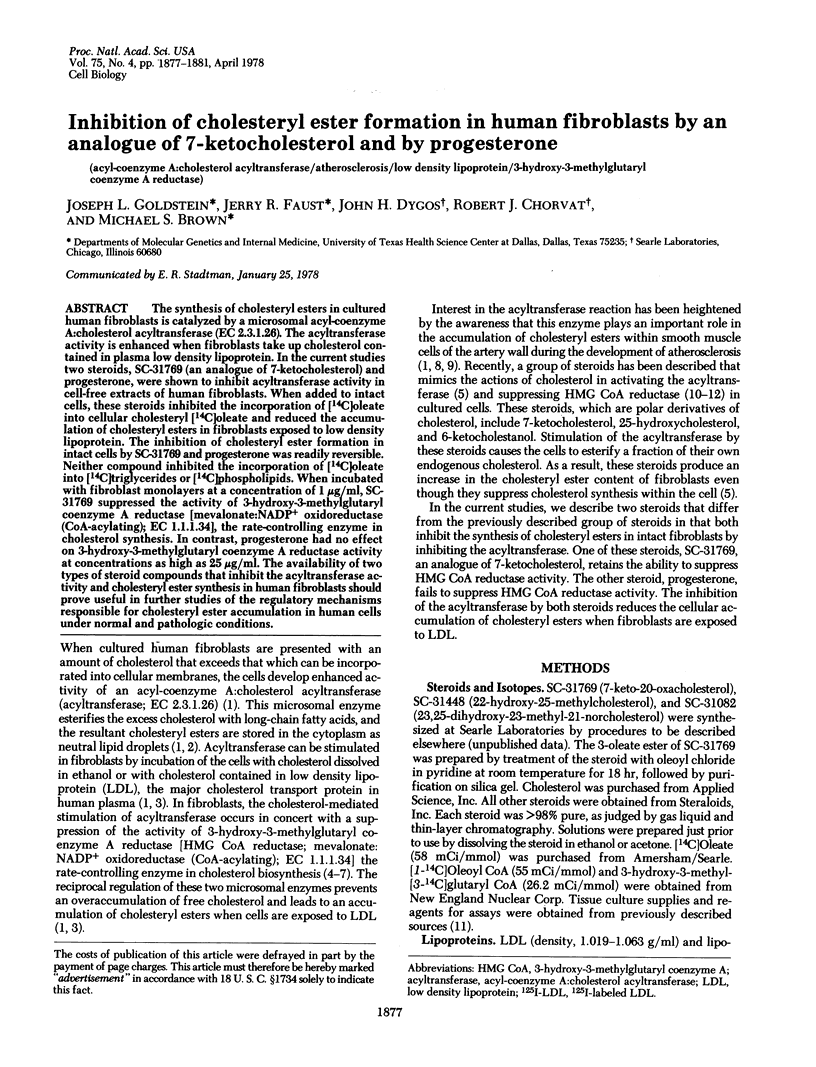
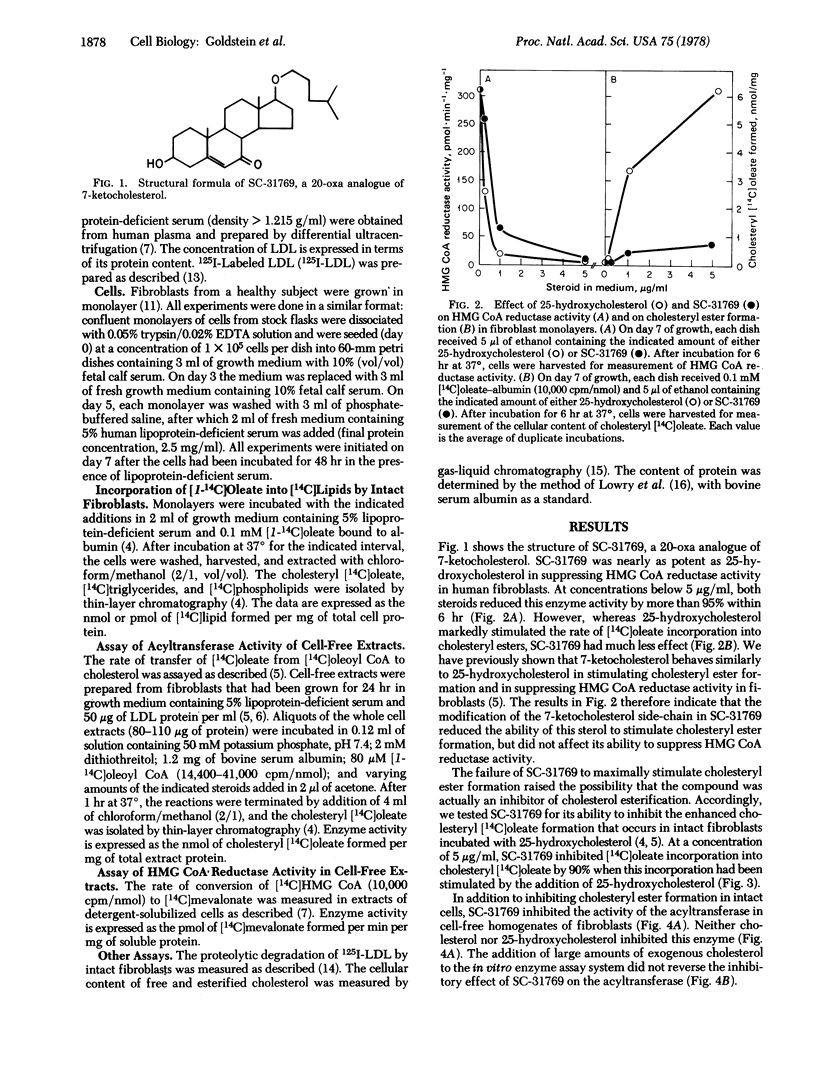
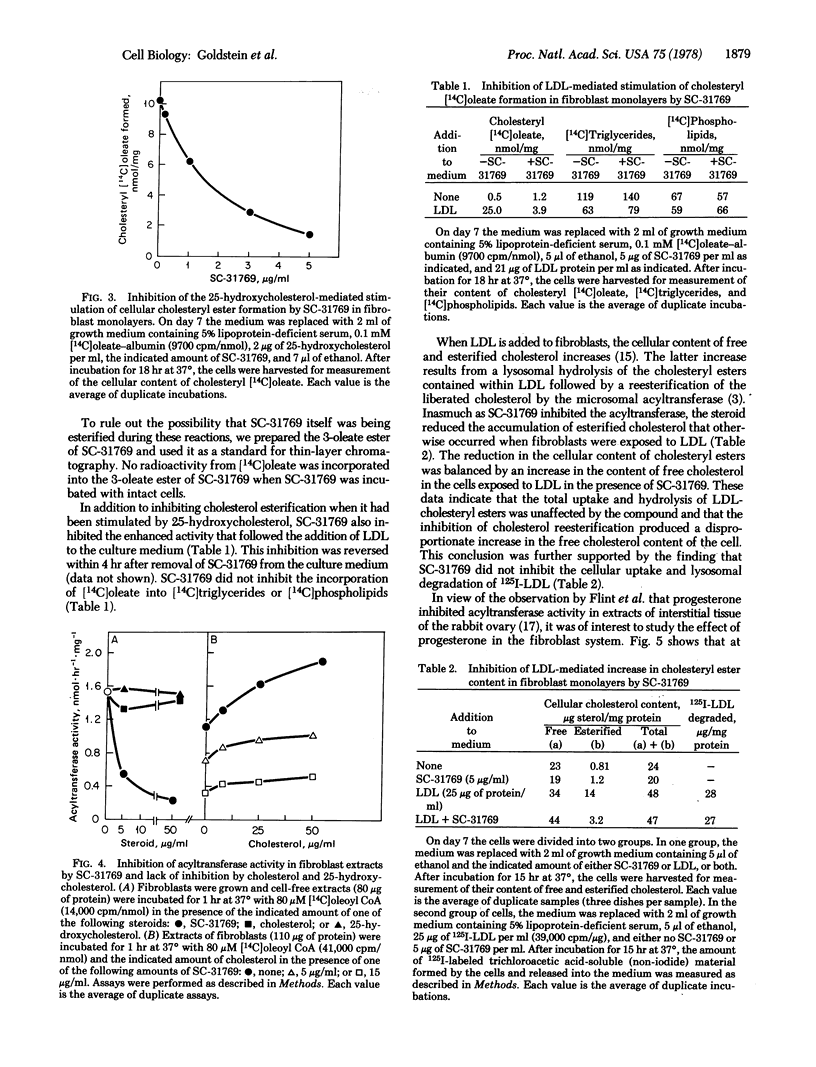
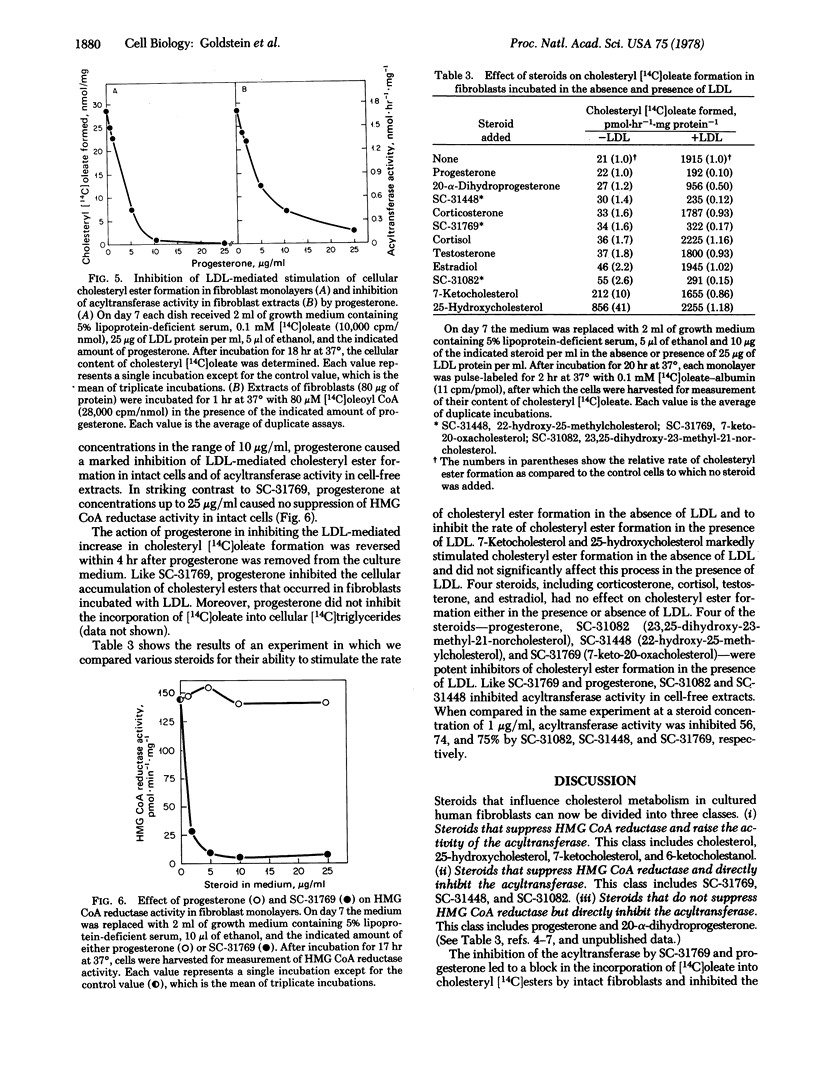
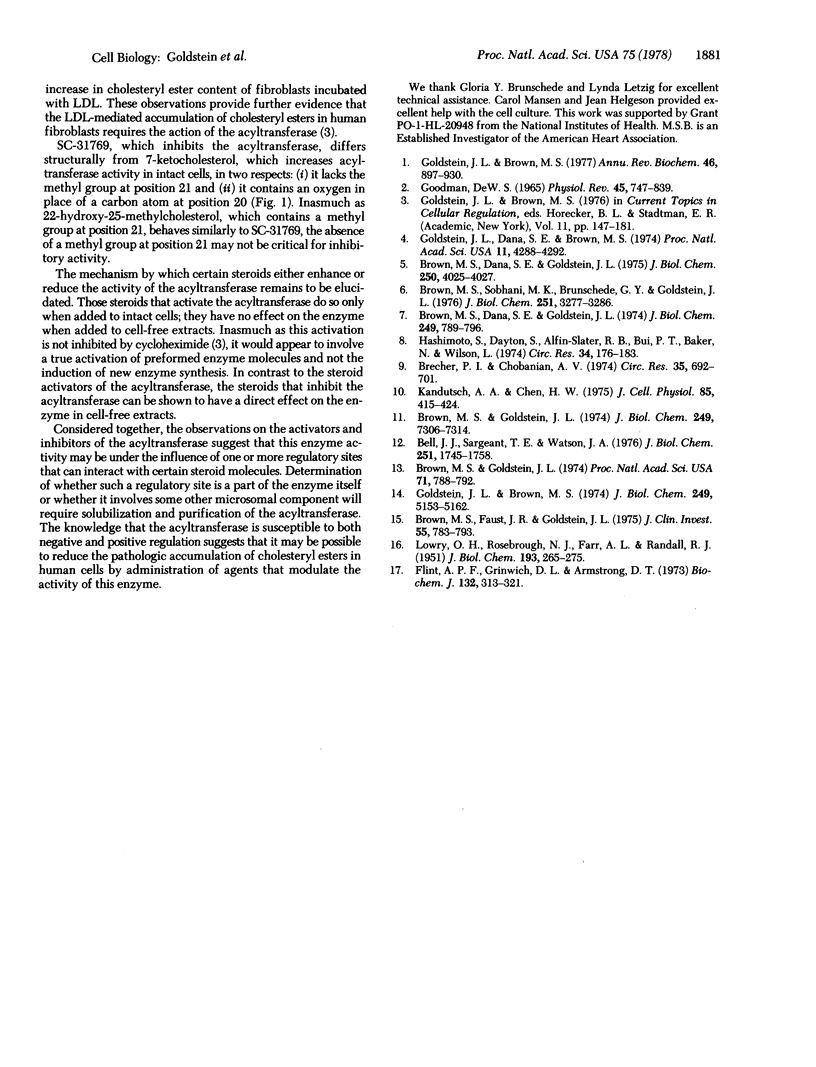
Selected References
These references are in PubMed. This may not be the complete list of references from this article.
- Bell J. J., Sargeant T. E., Watson J. A. Inhibition of 3-hydroxy-3-methylglutaryl coenzyme A reductase activity in hepatoma tissue culture cells by pure cholesterol and several cholesterol derivatives. Evidence supporting two distinct mechanisms.20l. J Biol Chem. 1976 Mar 25;251(6):1745–1758. [PubMed] [Google Scholar]
- Brecher P. I., Chobanian A. V. Cholesteryl ester synthesis in normal and atherosclerotic aortas of rabbits and rhesus monkeys. Circ Res. 1974 Nov;35(5):692–701. doi: 10.1161/01.res.35.5.692. [DOI] [PubMed] [Google Scholar]
- Brown M. S., Dana S. E., Goldstein J. L. Cholesterol ester formation in cultured human fibroblasts. Stimulation by oxygenated sterols. J Biol Chem. 1975 May 25;250(10):4025–4027. [PubMed] [Google Scholar]
- Brown M. S., Dana S. E., Goldstein J. L. Regulation of 3-hydroxy-3-methylglutaryl coenzyme A reductase activity in cultured human fibroblasts. Comparison of cells from a normal subject and from a patient with homozygous familial hypercholesterolemia. J Biol Chem. 1974 Feb 10;249(3):789–796. [PubMed] [Google Scholar]
- Brown M. S., Faust J. R., Goldstein J. L. Role of the low density lipoprotein receptor in regulating the content of free and esterified cholesterol in human fibroblasts. J Clin Invest. 1975 Apr;55(4):783–793. doi: 10.1172/JCI107989. [DOI] [PMC free article] [PubMed] [Google Scholar]
- Brown M. S., Goldstein J. L. Familial hypercholesterolemia: defective binding of lipoproteins to cultured fibroblasts associated with impaired regulation of 3-hydroxy-3-methylglutaryl coenzyme A reductase activity. Proc Natl Acad Sci U S A. 1974 Mar;71(3):788–792. doi: 10.1073/pnas.71.3.788. [DOI] [PMC free article] [PubMed] [Google Scholar]
- Brown M. S., Goldstein J. L. Suppression of 3-hydroxy-3-methylglutaryl coenzyme A reductase activity and inhibition of growth of human fibroblasts by 7-ketocholesterol. J Biol Chem. 1974 Nov 25;249(22):7306–7314. [PubMed] [Google Scholar]
- Brown M. S., Sobhani M. K., Brunschede G. Y., Goldstein J. L. Restoration of a regulatory response to low density lipoprotein in acid lipase-deficient human fibroblasts. J Biol Chem. 1976 Jun 10;251(11):3277–3286. [PubMed] [Google Scholar]
- Flint A. P., Grinwich D. L., Armstrong D. T. Control of ovarian cholesterol ester biosynthesis. Biochem J. 1973 Feb;132(2):313–321. doi: 10.1042/bj1320313. [DOI] [PMC free article] [PubMed] [Google Scholar]
- Goldstein J. L., Brown M. S. Binding and degradation of low density lipoproteins by cultured human fibroblasts. Comparison of cells from a normal subject and from a patient with homozygous familial hypercholesterolemia. J Biol Chem. 1974 Aug 25;249(16):5153–5162. [PubMed] [Google Scholar]
- Goldstein J. L., Brown M. S. The low-density lipoprotein pathway and its relation to atherosclerosis. Annu Rev Biochem. 1977;46:897–930. doi: 10.1146/annurev.bi.46.070177.004341. [DOI] [PubMed] [Google Scholar]
- Goldstein J. L., Dana S. E., Brown M. S. Esterification of low density lipoprotein cholesterol in human fibroblasts and its absence in homozygous familial hypercholesterolemia. Proc Natl Acad Sci U S A. 1974 Nov;71(11):4288–4292. doi: 10.1073/pnas.71.11.4288. [DOI] [PMC free article] [PubMed] [Google Scholar]
- Goodman D. S. Cholesterol ester metabolism. Physiol Rev. 1965 Oct;45(4):747–839. doi: 10.1152/physrev.1965.45.4.747. [DOI] [PubMed] [Google Scholar]
- Hashimoto S., Dayton S., Alfin-Slater R. B., Bui P. T., Baker N., Wilson L. Characteristics of the cholesterol-esterifying activity in normal and atherosclerotic rabbit aortas. Circ Res. 1974 Feb;34(2):176–183. doi: 10.1161/01.res.34.2.176. [DOI] [PubMed] [Google Scholar]
- Kandutsch A. A., Chen H. W. Regulation of sterol synthesis in cultured cells by oxygenated derivatives of cholesterol. J Cell Physiol. 1975 Apr;85(2 Pt 2 Suppl 1):415–424. doi: 10.1002/jcp.1040850408. [DOI] [PubMed] [Google Scholar]
- LOWRY O. H., ROSEBROUGH N. J., FARR A. L., RANDALL R. J. Protein measurement with the Folin phenol reagent. J Biol Chem. 1951 Nov;193(1):265–275. [PubMed] [Google Scholar]


